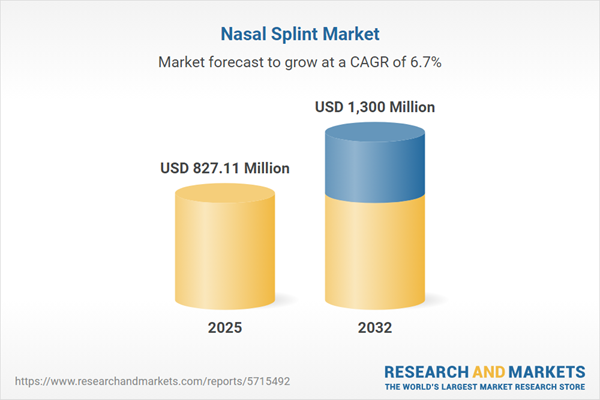Speak directly to the analyst to clarify any post sales queries you may have.
As healthcare procurement faces increased complexity, the global nasal splint market is adapting to shifting demands with a heightened focus on advanced materials, resilient supply strategies, and responsive regulatory compliance. Senior decision-makers navigating this environment require targeted intelligence to make sourcing decisions that directly impact patient outcomes and operational efficiency.
Market Snapshot: Global Nasal Splint Market Size and Growth
The global nasal splint market achieved a value of USD 775.57 million in 2024 and is projected to rise to USD 827.11 million by 2025. By 2032, forecasts indicate the market will reach USD 1.30 billion, equating to a compound annual growth rate (CAGR) of 6.69% throughout the forecast period.
This growth trajectory is underpinned by an increase in surgical interventions, ongoing adoption of nasal splints in both acute and elective settings, and a stronger emphasis on clinical best practices. Upgrades in biocompatible materials and the adoption of digital procurement tools are making supply chains more agile, capable of meeting the evolving operational and compliance landscape within healthcare organizations.Scope & Segmentation: Nasal Splint Market Segments and Technologies
This report equips senior leaders with a structured approach for evaluating procurement opportunities, streamlining technology adoption, and designing efficient workflows tailored to modern health systems. A comprehensive view of key segments ensures organizations can align sourcing models with specific operational and clinical priorities across global markets:
- Product Types: External and internal nasal splints designed for use in trauma, elective, and emergency surgical care.
- Distribution Channels: Hospital pharmacies, manufacturers' direct channels, e-commerce, and traditional retail outlets, offering diverse fulfillment options.
- Applications: Utilization in trauma management, cosmetic and reconstructive surgeries, as well as post-operative recovery in both inpatient and home settings.
- End Users: Facilities including hospitals, outpatient clinics, and home care agencies, each with specific procurement and workflow requirements.
- Material Types: Choices between metal, plastic, and medical-grade silicone, balancing patient comfort, compliance, and device longevity.
- Regions Analyzed: Americas, Europe, Middle East, Africa, and Asia-Pacific, each characterized by unique regulatory frameworks and procurement challenges.
- Key Companies Covered: Medtronic plc, Smith+Nephew plc, Meril Life Sciences, Spiggle & Theis Medizintechnik, Entellus Medical, Acclarent, ConMed Corporation, Teleflex, Integra LifeSciences, and Olympus Corporation, all influencing competitive strategies and regional approaches.
Nasal Splint Market: Key Takeaways for Senior Leaders
- Silicone-based nasal splints with enhanced antimicrobial features support infection control and task patient safety in high-acuity settings.
- Strategic adoption of digital supply chain management improves cross-functional collaboration and elevates supply oversight for timely procurement results.
- Sourcing from regional suppliers, combined with proactive contract management, can reduce risk and facilitate ongoing compliance with regulatory changes.
- Collaborative efforts between contract manufacturers and research bodies are streamlining product innovation and workflow customization for clinical needs.
- Implementing flexible and modular procurement strategies enables healthcare providers to maintain supply continuity and respond to market uncertainties effectively.
- Utilization of custom-fit nasal splint solutions allows providers to tailor patient treatment, enhancing both procedural workflow and post-operative recovery experiences.
Tariff Impact: Navigating United States Policy in 2025
Recent tariffs on nasal splint components in the United States have led procurement executives to adjust supply chain practices. Emphasis is now on fostering relationships with domestic sources, amending contract terms, and updating procurement procedures to control costs and remain aligned with evolving policy mandates.
Methodology & Data Sources
This report is built upon in-depth interviews with surgeons and key procurement stakeholders, complemented by peer-reviewed literature. The analytical process ensures a high degree of accuracy and relevance, focusing on actionable insights to support modernization of healthcare supply strategies.
Why This Nasal Splint Market Report Matters
- Guides decision-makers through each phase of procurement, from option assessment to full-scale implementation, using industry data and insights.
- Supports timely adaptation of product choices and distribution pathways in response to dynamic regulatory and market standards.
- Delivers intelligence that boosts resilience and compliance within complex healthcare supply chains while supporting strategic sourcing decisions.
Conclusion
This report provides senior healthcare leadership with strategic tools to refine procurement and navigate persistent industry evolution. The actionable intelligence presented empowers enhanced supply chain management and supports competitive advancement in the nasal splint market.
Additional Product Information:
- Purchase of this report includes 1 year online access with quarterly updates.
- This report can be updated on request. Please contact our Customer Experience team using the Ask a Question widget on our website.
Table of Contents
3. Executive Summary
4. Market Overview
7. Cumulative Impact of Artificial Intelligence 2025
Companies Mentioned
The companies profiled in this Nasal Splint market report include:- Medtronic plc
- Smith+Nephew plc
- Meril Life Sciences Pvt. Ltd.
- Spiggle & Theis Medizintechnik GmbH
- Entellus Medical, Inc.
- Acclarent, Inc.
- ConMed Corporation
- Teleflex Incorporated
- Integra LifeSciences Holdings Corporation
- Olympus Corporation
Table Information
| Report Attribute | Details |
|---|---|
| No. of Pages | 184 |
| Published | October 2025 |
| Forecast Period | 2025 - 2032 |
| Estimated Market Value ( USD | $ 827.11 Million |
| Forecasted Market Value ( USD | $ 1300 Million |
| Compound Annual Growth Rate | 6.6% |
| Regions Covered | Global |
| No. of Companies Mentioned | 11 |








